Dawn of Japanese PhotographyⅡ
Chubu district, Kinki district & Chugoku district
Mar. 7—May. 10, 2009
- Mar. 7—May. 10, 2009
- Closed Monday (Tuesday if Monday is a national holiday)
- Admission:Adults¥500(400)/College Students ¥400(320)/High School and Junior High School Students, Over 65 ¥250(200)
The Dawn of Japanese Photography series is the outgrowth of a thorough study by the Tokyo Metropolitan Museum of Photography of all public institutions in Japan, including museums and archives, whose collections include photographs and related materials from approximately 1850 to 1890, from the closing years of the Tokugawa shogunate through the mid Meiji period. The study uncovered a wealth of photographs and other materials, which are being organized into the Dawn of Japanese Photography series. This exhibition, the second in the series, focuses on early photography from the Chubu, Kinki, and Chugoku regions of Japan. Photography, which was introduced to Japan in 1848, during the closing years of the Tokugawa Shogunate, was the leading-edge technology of its day. Arriving as the country was being opened to the outside world, it was truly a symbol of modern Western civilization. As Yokohama, Nagasaki, and other ports were opened to foreign trade, Japanese photographers, having learned their skills through contact with foreign photographers visiting Japan, set to work throughout the country: Ukai Gyokuzen in Edo, Ueno Hikoma and Shimooka Renjo in Nagasaki and Yokohama, for example. Their work captured vivid images of Japan and the Japanese from the 1850s on for the enjoyment of later generations.
Even prior to its recognition as an art form, photography was, unconsciously or not, artistic; these early works are precious as far more than historical sources. But how many early photographs have survived?
This exhibition, continuing the work of the first The Dawn of Japanese Photography exhibition, which focused on photographers active in the Kanto area, presents a large group of original photographs never before shown in Tokyo together with a wide variety of other exhibits, including cameras and ukiyo-e prints, relating to early photography. Some are from the museum’s collection; others were discovered through on-site research by our curators, based on a questionnaire survey of about 2,000 institutions in the Chubu, Kansai, and Chugoku areas. That laborious curatorial legwork unearthed many of the precious photographs and materials presented in this exhibition. These early photographs are more than enjoyable images. Many are preserved with beautiful bindings and handsome texts and can be appreciated as total works of art. The handsome presentation of these images at the dawn of photography thought-provokingly foreshadows the maturation of photography as an art form.
As the museum continues its research on the transmission and popularization of photography, planning is already underway for the third exhibiton, on Shikoku and Kyushu, and the fourth, on Hokkaido and the Tohoku. They will be followed by a comprehensive exhibition to provide a complete view of the state of early photographs surviving in Japan.
○Organization of the Exhibition
In this exhibition, invaluable surviving original photographs and related materials will be presented in three sections: 1) First Contact, 2) Learning and 3) Expanding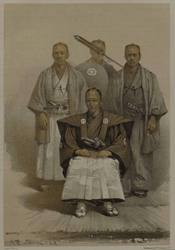
『ペリー日本遠征記』 フランシス・L・ホークス 安政3(1856)年より 東京都写真美術館蔵
1. First Contact
This section introduces Japan’s first contact with photography through the Narrative of the Expedition of an American Squadron to the China Seas and Japan, Performed in the Years 1852, 1853, and 1854, under the Command of Commodore M.C. Perry, United States Navy (with illustrations based on the oldest known photographs of Japan). In addition, this section includes photographs taken by members of the shogunate’s 1860 mission to the United States during their travels there.
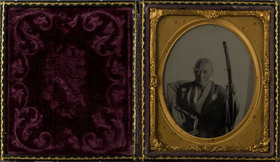
《長澤与四郎像》 撮影者不詳 アンブロタイプ 万延元 (1860)年頃 伊豆の国市韮山郷土資料館寄託
2. Learning
This section introduces work from the period in which photography was beginning to gain a foothold in Japan. Photographs by Ukai Gyokusen, Japan’s first commercial photographer, are shown together with photographs that may antedate Gyokusen’s work, materials related to Japanese research on photography in the 1850s and 1860s, and photographs by Kojima Ryua of Mino, who studied photography and later became a professional photographer.
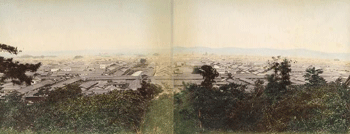
《大阪城から見たパノラマ》 内田九一 鶏卵紙に手彩色 明治初(1868-1877)年 内田写真株式会社蔵)
3. Spreading
An ambrotype of samurai, shot during the Battle of Toba-Fushima (1868), close ups and group photographs from early Meiji, panoramic photographs of street scenes, albums bringing together photographs of famous places: this section shows how photography spread to become a medium with social functions as well as a private pleasure.
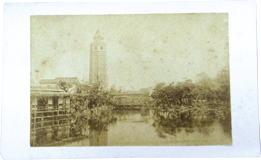
《浅草十二階》 鶏卵紙 撮影者不詳 明治時代中期 高石市郷土資料室蔵
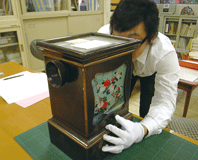
名刺判覗きからくり 明治時代 高石市郷土資料室蔵


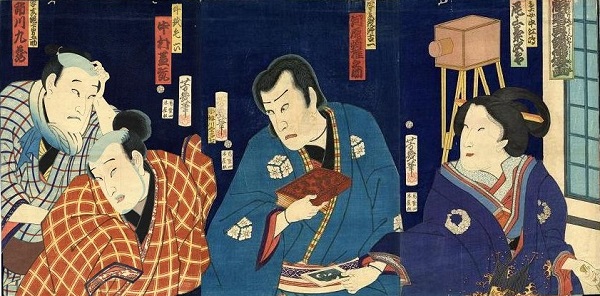
![チラシ1[pdf]](http://topmuseum.jp/upload/4/93/thums/2009_002_yoakemae.png)
![出品作品リスト2[pdf]](http://topmuseum.jp/upload/3/92/thums/yoake2.png)
![出品作品リスト1[pdf]](http://topmuseum.jp/upload/4/93/thums/yoake1.png)